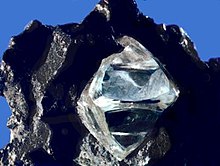| Diamond | |
|---|---|
 An octahedral diamond crystal in matrix | |
| General | |
| Category | Native Nonmetal, Mineral |
| Formula (repeating unit) | Carbon (C) |
| Crystal system | Diamond cubic (a = 3.56683 Å) |
| Identification | |
| Color | Most often colorless to yellow or brown; rarely pink, orange, green, blue, gray, or red |
| Crystal habit | Octahedral, cubo-octahedral, spherical, or cubic |
| Cleavage | Perfect; parallel to the octahedral face |
| Fracture | Irregular |
| Mohs scale hardness | 10 |
| Streak | white |
| Diaphaneity | Clear to not |
| Specific gravity | 3.516–3.525 |
| Refractive index | 2.417 |
| Pleochroism | None |
| Fusibility | Burns above 700 °C in air. |
| Solubility | Resistant to acids, but dissolves irreversibly in hot steel |
| Other characteristics | boiling point = none, very low vapor pressure before decomposing in solid state |
| Major varieties | |
| Ballas | Spherical, radial structure, cryptocrystalline, opaque black |
| Bort | Poorly formed, cryptocrystalline, shapeless, translucent |
| Carbonado | Massive, microcrystalline, opaque black |
Diamond is the allotrope of carbon in which the carbon atoms are arranged in the specific type of cubic lattice called diamond cubic. It is a crystal that is transparent to opaque and which is generally isotropic (no or very weak birefringence). Diamond is the hardest naturally occurring material known. Yet, due to important structural brittleness, bulk diamond's toughness is only fair to good. The precise tensile strength of bulk diamond is little known; however, compressive strength up to 60 GPa has been observed, and it could be as high as 90–100 GPa in the form of micro/nanometer-sized wires or needles (~100–300 nm in diameter, micrometers long), with a corresponding maximum tensile elastic strain in excess of 9%.[1][2] The anisotropy of diamond hardness is carefully considered during diamond cutting. Diamond has a high refractive index (2.417) and moderate dispersion (0.044) properties that give cut diamonds their brilliance. Scientists classify diamonds into four main types according to the nature of crystallographic defects present. Trace impurities substitutionally replacing carbon atoms in a diamond's crystal structure, and in some cases structural defects, are responsible for the wide range of colors seen in diamond. Most diamonds are electrical insulators and extremely efficient thermal conductors. Unlike many other minerals, the specific gravity of diamond crystals (3.52) has rather small variation from diamond to diamond.
- ^ Dang, Chaoqun; et al. (January 1, 2021). "Achieving large uniform tensile elasticity in microfabricated diamond". Science. 371 (6524): 76–78. Bibcode:2021Sci...371...76D. doi:10.1126/science.abc4174. PMID 33384375.
- ^ Banerjee, Amit; et al. (20 Apr 2018). "Ultralarge elastic deformation of nanoscale diamond". Science. 360 (6386): 300–302. Bibcode:2018Sci...360..300B. doi:10.1126/science.aar4165. PMID 29674589.
